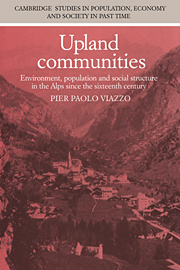 Upland Communities
Upland Communities Book contents
- Frontmatter
- Contents
- List of illustrations
- List of tables
- List of abbreviations
- Acknowledgements
- Introduction: anthropology, historical demography and the study of mountain societies
- 1 Environment, population and social structure: the Alpine village as an ecosystem
- 2 Open systems, open questions
- 3 Anthropologists in the Alps
- 4 The changing demography of Alpine communities
- 5 The traditional economy and its demise
- 6 The causes and consequences of Alpine emigration
- 7 The wealth from the earth: mining and immigration
- 8 Population, resources and homeostatic regulation
- 9 The domestic domain
- 10 Upland communities
- A summary of conclusions
- Bibliography
- Index
9 - The domestic domain
Published online by Cambridge University Press: 13 October 2009
- Frontmatter
- Contents
- List of illustrations
- List of tables
- List of abbreviations
- Acknowledgements
- Introduction: anthropology, historical demography and the study of mountain societies
- 1 Environment, population and social structure: the Alpine village as an ecosystem
- 2 Open systems, open questions
- 3 Anthropologists in the Alps
- 4 The changing demography of Alpine communities
- 5 The traditional economy and its demise
- 6 The causes and consequences of Alpine emigration
- 7 The wealth from the earth: mining and immigration
- 8 Population, resources and homeostatic regulation
- 9 The domestic domain
- 10 Upland communities
- A summary of conclusions
- Bibliography
- Index
Summary
Anthropological models of the Alpine household
Over the last few decades, the emergence of common areas of research on the border between history and anthropology has led many anthropologists to acquire greater familiarity with the methods and techniques of historical demography. For their part, historical demographers are now paying more attention to the work of anthropologists, and the growing emphasis they are placing on nuptiality is likely to further increase their interest in a number of topics which have long been of primary significance in the anthropological investigation of social structure. As E. A. Wrigley has recently observed, if it is recognized that marriage was central to European population history, then ‘questions such as the transmission of property between successive generations, authority structures within the family, patterns of co-residence and support, the institution of service, inheritance customs, and cognate matters, can scarcely fail to attract study’.
Indeed, the results of our historical survey indicate that in order to shed more light on several important yet elusive aspects of Alpine demography it is necessary to examine in more detail what Jack Goody has called ‘the domestic domain’, and in particular the nexus linking inheritance systems to nuptiality and family formation. Both historians and anthropologists have widely assumed that impartible inheritance will produce low levels of nuptiality and a predominance of stemfamily households, whereas partibility should result in early marriage, moderate rates of permanent celibacy, and a high proportion of nuclear families.
- Type
- Chapter
- Information
- Upland CommunitiesEnvironment, Population and Social Structure in the Alps since the Sixteenth Century, pp. 224 - 257Publisher: Cambridge University PressPrint publication year: 1989


